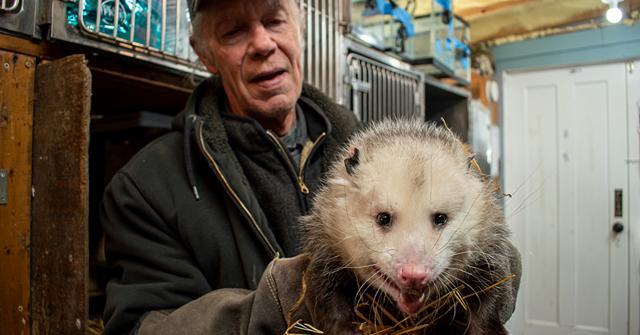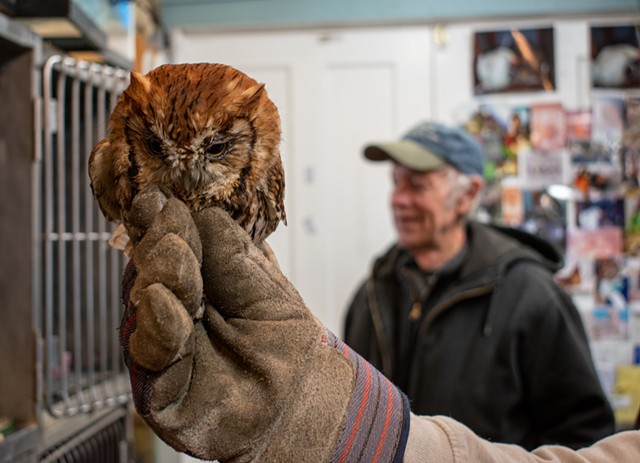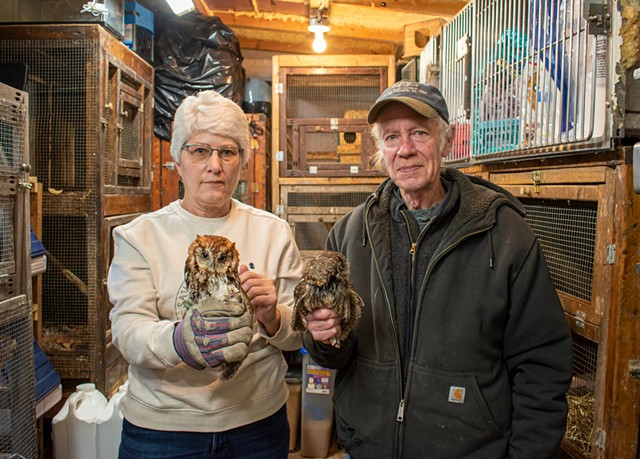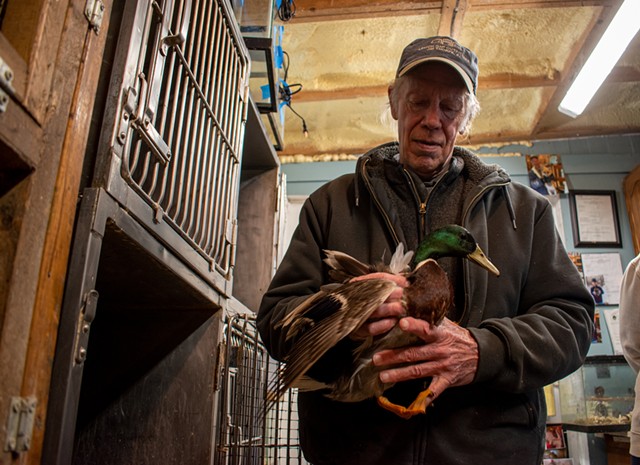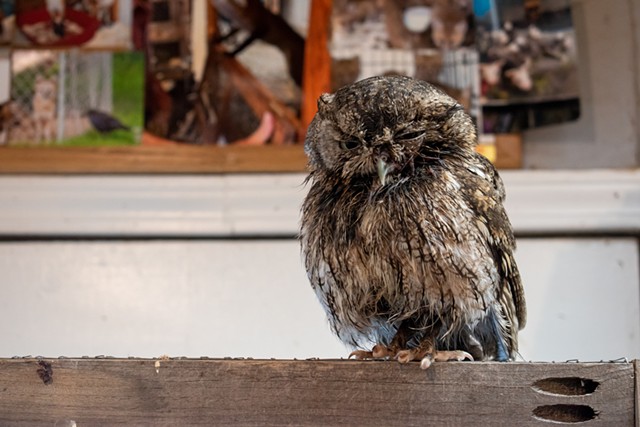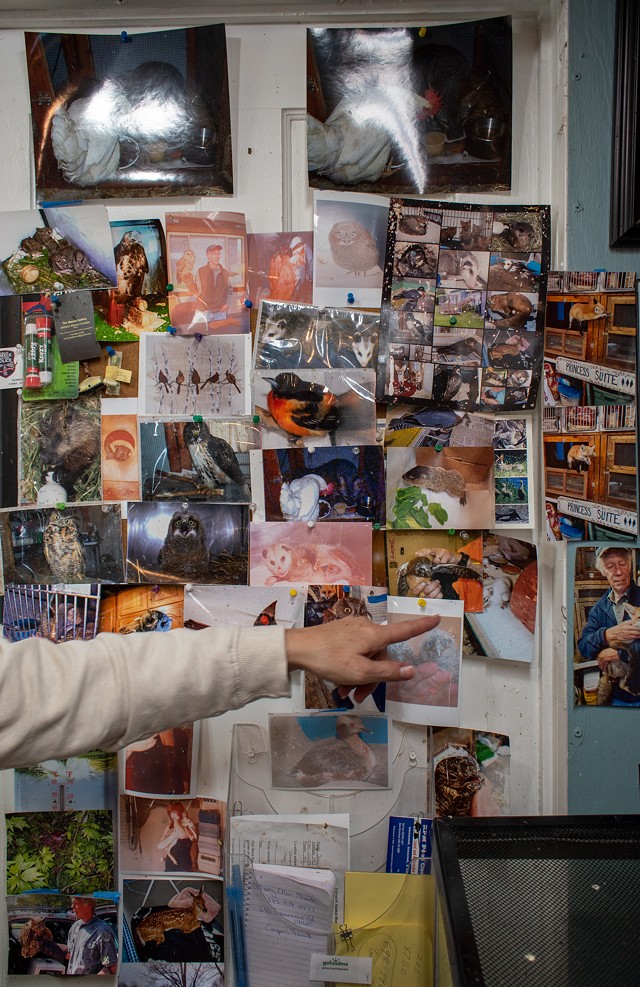[
{
"name": "500x250 Ad",
"insertPoint": "5",
"component": "15667920",
"parentWrapperClass": "",
"requiredCountToDisplay": "1"
}
]
Perhaps the most striking thing about the outside of Bill Bellman’s home in Greece to anyone who knows what waits inside is the ordinariness of it.
The quaint, baby blue ranch he shares with his wife, Veronica, looks like a typical home in a typical American suburb. The garage is slightly cluttered, the way most are, with shovels, rakes, and tools hanging on the wall. Yet, in the air lingers a distinctive, seemingly out of place odor of musk, the kind one might expect walking through a zoo on a warm summer’s day.
The source of the odor lies behind a door at the rear of the garage that opens into a literal wild kingdom: about 300 square feet of space housing cages holding wild animals, each of them on the mend.
There are two screech owls, each blinded in one eye. There is a wounded pigeon. A pair of opossums infected with a species-specific disease recover nearby. There is a duck with seemingly nothing physically wrong with it, except that it refuses to fly.
“You can’t turn down something that’s hurt,” Bellman said. “It needs help, and none of these guys know they need help.”
For more than a decade, Bellman has been a state Department of Environmental Conservation-licensed wildlife rehabilitator whose dedication to the volunteer pursuit has earned him the nickname “Wildlife Bill” among people who have turned to him for help. In the past year, Bellman said he took in over 500 injured animals and was able to release about half of them back into the wild.
GIVING ANIMALS A SECOND CHANCE AT LIFE
Bellman, a Kodak retiree and grandfather, got his start working with animals as a volunteer with Greece Residents Assisting Stray Pets (GRASP).
But it was a faceoff with his own mortality about 12 years ago that moved him to dedicate his life to animals.
Shortly after getting certified by the state, Bellman was diagnosed with a form of gastro-esophageal cancer. The outlook wasn’t good — he said his chances of surviving were about 30 percent at the time. His wildlife work was sidelined for about a year as he underwent treatment.
Bellman’s health eventually improved, though, and he attacked his wildlife work with a newfound devotion.
“I got a second chance at life, and I’m giving it to the animals,” Bellman said.
Bellman is a tall, slender man in his early 70s whose bright blue eyes light up when he talks about the animals he has tended to at his home.
He recalled his most unusual boarder as being a porcupine with an injured tail that he picked up near a Wegmans in Brockport after someone called him for help. Another unique guest was an injured bald eagle Bellman captured in Riga that gave him a shiner in the process.
“He tried to take off again, landed in a tree, and then landed in a bush, so I covered his head up with a net, because, you know, they can poke right into your skull and their talons are as big as your hand,” Bellman said. “And I reach for them, and he comes back with his left wing, and I got pictures of my black eye, just like a hammer, boom!”
Bellman’s backyard is fitted with a makeshift aviary for larger birds, as well as dozens of additional cages and traps. During its stay, the eagle received pro bono medical care at Churchville Animal Hospital and was eventually released into the wild.
Rick Parsons is the veterinarian who looked after the eagle. He described Bellman as a “fun, goofy guy” who is dedicated to the animals.
“I look at it like, this is my profession, and even I don’t like to take calls when I’m off duty,” Parsons said. “These (rehabilitators) are always taking calls, they’re ready in the middle of the night to go pick up an animal.”
On every wall of Bellman’s workshop are photos of his favorite animals. There was the brain-damaged gray fox who made friends with a chicken, his natural prey. There was the oversized opossum Bellman tried in vain to walk using a harness.
Then there was “Princess,” a kindly female fox that Bellman had hoped would become a training animal.
Bellman keeps a photo on the wall of Princess taking a marshmallow out of his mouth.
“That’s how much I trusted her,” Bellman said.
His partner in animal care, Laurie Case, recalled how well behaved Princess was.
“She’d sit there and watch us clean and the door would be open,” Case said.
Princess became a beloved fixture around the workshop, and visitors from animal control would often bring her toys. One day, the story goes, Bellman found the toys strewn about the lawn. The next day, they were scattered even farther out.
It turned out that Princess had her eye on a male and she was working to lure him in. Eventually, the little vixen ran off with her tod.
“I mean, that’s good, she found a boyfriend, but you worry about how she’s going to be,” Bellman said, his voice cracking a bit. “But you can’t do that, it’s a wild animal.”
'YOU CAN'T SAVE THEM ALL'
Inside the workshop, a gray screech owl swoops around, drifting silently from perch to perch as Bellman regales guests with stories of his animal adventures.
Though blind in its left eye, the owl was ready to make its way back into the wild, a moment Bellman cherished and counted as a job well done. But not every case has a cheery outcome.
About half the animals Bellman takes in are too far gone to save. In those cases, he euthanizes them using carbon dioxide, a method considered one of the most humane ways to put down animals.
Their remains are either buried in his yard or discarded in the trash.
“They don’t come in on vacation, there’s always something wrong,” Bellman said. “I have to euthanize sometimes, it’s just something you need to do.”
Bellman is one of 14 certified wildlife rehabilitators in Monroe County, according to the Department of Environmental Conservation. He is one of two who the DEC lists as taking in birds.
Bellman has been able to split a lot of his duties with Case, whom he calls his “rehab wife.” He started working with Case three years ago, when she brought him an injured woodchuck.
“At this point, I know what he’s thinking before he even says it,” Case said.
Bellman said he’ll take in just about any animal, except for those known for being rabies vectors, such as raccoons, bats, and skunks.
Mike Wasilco, the DEC’s regional wildlife manager for the Finger Lakes, said rehabbers like Bellman play only a minor role in conservation efforts. Most of the animals they take in are common and nature would move on if they didn’t survive their illness or injury, Wasilco said.
But, he added, rehabbers reflect what he called the “human aspect” of wildlife work.
“It provides an outlet where when someone calls in that they found a baby rabbit, or their dog found a nest of baby rabbits, or the fawn that the doe is dead on the side of the road after it got hit by a car and the fawn’s standing over it,” Wasilco said. “Those baby animals would die if left in the wild, and the population wouldn’t be negatively impacted. But the humans that are involved that come across it, they feel a lot of compassion for these animals, and the rehabilitators take those animals in and see if anything can be done.”
Bellman has been bitten and scratched more times than he can count. He funds his work out of his own pocket, with some support from donors to his GoFundMe account.
Meanwhile, the pursuit eats up just about all of his free time. His morning routine with his animal wards takes about three hours.
When asked what it would take for him to retire from rehabilitating, Bellman smiled.
“My wife asks me all the time, ‘When are you going to stop doing it?’” Bellman said. “I tell her, ‘I’ll keep doing it until the day after I die.’”
Gino Fanelli is a CITY staff writer. He can be reached at (585)775-9692 or [email protected].
The quaint, baby blue ranch he shares with his wife, Veronica, looks like a typical home in a typical American suburb. The garage is slightly cluttered, the way most are, with shovels, rakes, and tools hanging on the wall. Yet, in the air lingers a distinctive, seemingly out of place odor of musk, the kind one might expect walking through a zoo on a warm summer’s day.
The source of the odor lies behind a door at the rear of the garage that opens into a literal wild kingdom: about 300 square feet of space housing cages holding wild animals, each of them on the mend.
There are two screech owls, each blinded in one eye. There is a wounded pigeon. A pair of opossums infected with a species-specific disease recover nearby. There is a duck with seemingly nothing physically wrong with it, except that it refuses to fly.
“You can’t turn down something that’s hurt,” Bellman said. “It needs help, and none of these guys know they need help.”
For more than a decade, Bellman has been a state Department of Environmental Conservation-licensed wildlife rehabilitator whose dedication to the volunteer pursuit has earned him the nickname “Wildlife Bill” among people who have turned to him for help. In the past year, Bellman said he took in over 500 injured animals and was able to release about half of them back into the wild.
GIVING ANIMALS A SECOND CHANCE AT LIFE
Bellman, a Kodak retiree and grandfather, got his start working with animals as a volunteer with Greece Residents Assisting Stray Pets (GRASP).
But it was a faceoff with his own mortality about 12 years ago that moved him to dedicate his life to animals.
Shortly after getting certified by the state, Bellman was diagnosed with a form of gastro-esophageal cancer. The outlook wasn’t good — he said his chances of surviving were about 30 percent at the time. His wildlife work was sidelined for about a year as he underwent treatment.
Bellman’s health eventually improved, though, and he attacked his wildlife work with a newfound devotion.
“I got a second chance at life, and I’m giving it to the animals,” Bellman said.
Bellman is a tall, slender man in his early 70s whose bright blue eyes light up when he talks about the animals he has tended to at his home.
He recalled his most unusual boarder as being a porcupine with an injured tail that he picked up near a Wegmans in Brockport after someone called him for help. Another unique guest was an injured bald eagle Bellman captured in Riga that gave him a shiner in the process.
“He tried to take off again, landed in a tree, and then landed in a bush, so I covered his head up with a net, because, you know, they can poke right into your skull and their talons are as big as your hand,” Bellman said. “And I reach for them, and he comes back with his left wing, and I got pictures of my black eye, just like a hammer, boom!”
Bellman’s backyard is fitted with a makeshift aviary for larger birds, as well as dozens of additional cages and traps. During its stay, the eagle received pro bono medical care at Churchville Animal Hospital and was eventually released into the wild.
Rick Parsons is the veterinarian who looked after the eagle. He described Bellman as a “fun, goofy guy” who is dedicated to the animals.
“I look at it like, this is my profession, and even I don’t like to take calls when I’m off duty,” Parsons said. “These (rehabilitators) are always taking calls, they’re ready in the middle of the night to go pick up an animal.”
On every wall of Bellman’s workshop are photos of his favorite animals. There was the brain-damaged gray fox who made friends with a chicken, his natural prey. There was the oversized opossum Bellman tried in vain to walk using a harness.
Then there was “Princess,” a kindly female fox that Bellman had hoped would become a training animal.
Bellman keeps a photo on the wall of Princess taking a marshmallow out of his mouth.
“That’s how much I trusted her,” Bellman said.
His partner in animal care, Laurie Case, recalled how well behaved Princess was.
“She’d sit there and watch us clean and the door would be open,” Case said.
Princess became a beloved fixture around the workshop, and visitors from animal control would often bring her toys. One day, the story goes, Bellman found the toys strewn about the lawn. The next day, they were scattered even farther out.
It turned out that Princess had her eye on a male and she was working to lure him in. Eventually, the little vixen ran off with her tod.
“I mean, that’s good, she found a boyfriend, but you worry about how she’s going to be,” Bellman said, his voice cracking a bit. “But you can’t do that, it’s a wild animal.”
'YOU CAN'T SAVE THEM ALL'
Inside the workshop, a gray screech owl swoops around, drifting silently from perch to perch as Bellman regales guests with stories of his animal adventures.
Though blind in its left eye, the owl was ready to make its way back into the wild, a moment Bellman cherished and counted as a job well done. But not every case has a cheery outcome.
About half the animals Bellman takes in are too far gone to save. In those cases, he euthanizes them using carbon dioxide, a method considered one of the most humane ways to put down animals.
Their remains are either buried in his yard or discarded in the trash.
“They don’t come in on vacation, there’s always something wrong,” Bellman said. “I have to euthanize sometimes, it’s just something you need to do.”
Bellman is one of 14 certified wildlife rehabilitators in Monroe County, according to the Department of Environmental Conservation. He is one of two who the DEC lists as taking in birds.
Bellman has been able to split a lot of his duties with Case, whom he calls his “rehab wife.” He started working with Case three years ago, when she brought him an injured woodchuck.
“At this point, I know what he’s thinking before he even says it,” Case said.
Bellman said he’ll take in just about any animal, except for those known for being rabies vectors, such as raccoons, bats, and skunks.
Mike Wasilco, the DEC’s regional wildlife manager for the Finger Lakes, said rehabbers like Bellman play only a minor role in conservation efforts. Most of the animals they take in are common and nature would move on if they didn’t survive their illness or injury, Wasilco said.
But, he added, rehabbers reflect what he called the “human aspect” of wildlife work.
“It provides an outlet where when someone calls in that they found a baby rabbit, or their dog found a nest of baby rabbits, or the fawn that the doe is dead on the side of the road after it got hit by a car and the fawn’s standing over it,” Wasilco said. “Those baby animals would die if left in the wild, and the population wouldn’t be negatively impacted. But the humans that are involved that come across it, they feel a lot of compassion for these animals, and the rehabilitators take those animals in and see if anything can be done.”
Bellman has been bitten and scratched more times than he can count. He funds his work out of his own pocket, with some support from donors to his GoFundMe account.
Meanwhile, the pursuit eats up just about all of his free time. His morning routine with his animal wards takes about three hours.
When asked what it would take for him to retire from rehabilitating, Bellman smiled.
“My wife asks me all the time, ‘When are you going to stop doing it?’” Bellman said. “I tell her, ‘I’ll keep doing it until the day after I die.’”
Gino Fanelli is a CITY staff writer. He can be reached at (585)775-9692 or [email protected].
Latest in Culture
More by Gino Fanelli
-

DeWolf Brewing Company set to open in Victor
Apr 26, 2024 -
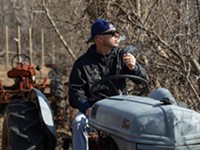
These small cannabis farmers say New York's legal weed rollout is ruining their lives
Mar 21, 2024 -
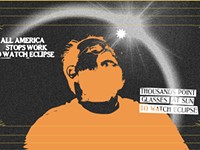
Man shakes fist at sun
Mar 15, 2024 - More »
Readers also liked…
-

Telltale signs
May 17, 2024
